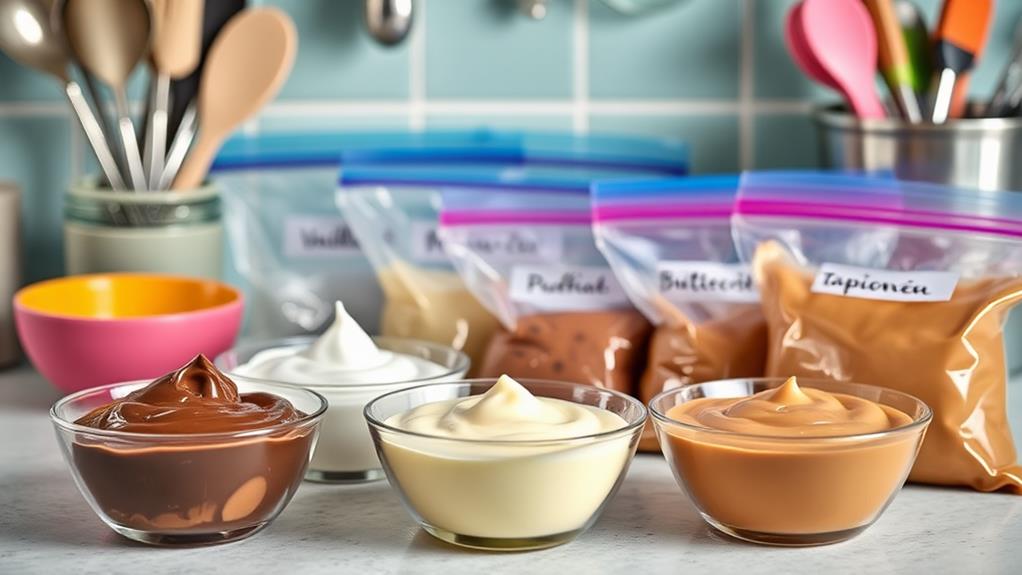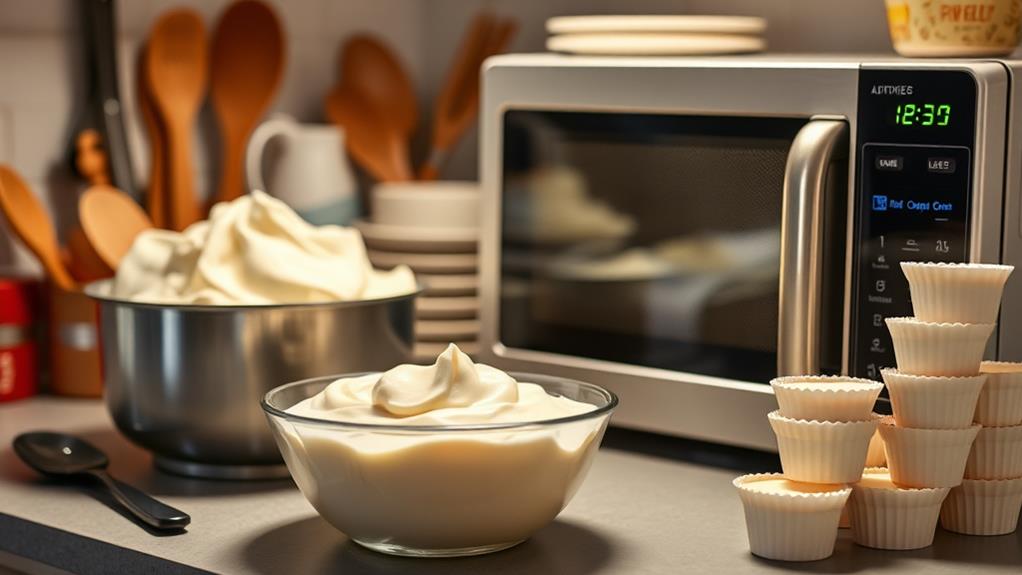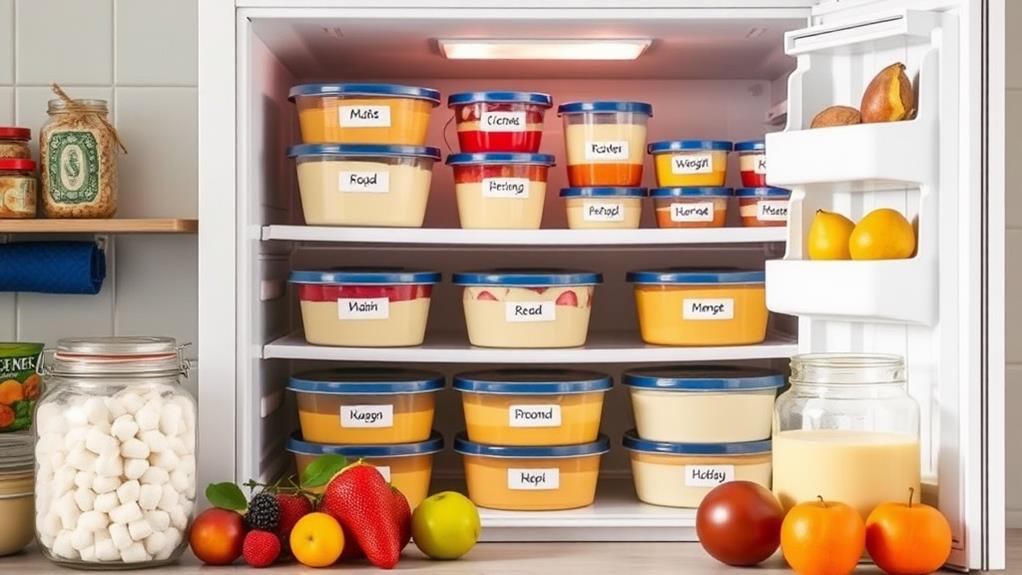Yes, you can freeze pudding to extend its shelf life and save those delicious leftovers. Make sure your pudding cools completely before freezing. Portion it out into airtight containers or resealable bags for easy access later. Be mindful, though, as not all puddings freeze well; avoid persimmon pudding and pudding pies, which can lose their texture and flavor. When you're ready to enjoy, thaw your pudding in the fridge overnight. You can also get creative with leftovers, turning them into trifles or adding them to smoothies. Stick around to discover more helpful money-saving tips and creative ideas!
Freezing Pudding Basics
When it comes to freezing pudding, understanding the basics is essential for preserving its taste and texture. First, make sure your pudding is fully cooled to room temperature before you freeze it. This step helps maintain its consistency and flavor, allowing you to enjoy it later without any unpleasant surprises.
To enhance your savings while enjoying treats, consider using budgeting tools that help track food expenses and manage your grocery budget effectively, promoting financial health.
To make things easier, consider cutting the pudding into smaller portions before freezing. This not only simplifies storage but also speeds up thawing when you're ready to enjoy a treat.
When you freeze pudding, use insulated lunch boxes, airtight plastic bags, or aluminum foil for wrapping. These options enhance its shelf-life in the freezer.
Don't forget to label and date all containers or bags used for freezing pudding. Keeping track of freshness is vital, as you'll want to consume it within three months for the best taste.
Finally, be cautious about which puddings you freeze; avoid persimmon pudding and pudding pie, as they can suffer significant texture and flavor changes upon thawing.
Best Storage Methods
To keep your frozen pudding in top shape, using the right storage methods is key. Here are some essential tips to guarantee your pudding stays fresh and delicious:
- Cool your pudding completely for 2-3 hours before wrapping. Efficient expense management apps can help you save on ingredients and avoid waste.
- Use airtight containers or resealable bags to prevent freezer burn.
- Label and date your storage containers for easy tracking.
Start by letting your pudding cool down entirely. This step is vital to avoid condensation, which can lead to ice crystals and spoilage.
Once cooled, wrap it tightly in plastic wrap or aluminum foil to eliminate air pockets. Then, place the wrapped pudding in a resealable plastic bag or an airtight container for extra protection.
Don't forget to label and date your containers! Short-term refrigeration lasts up to one month, while long-term freezing can keep your pudding fresh for up to a year.
Always store your pudding in a cool, dry place to maintain its quality. When it's time to enjoy, thaw it in the refrigerator overnight and reheat it gently.
Types of Pudding to Freeze

There are several types of puddings that freeze well, making them convenient options for future desserts. Homemade pudding varieties like rice and bread pudding can be successfully frozen for up to three months when prepared and stored correctly.
Just remember to cool them to room temperature before putting them in the freezer to maintain their texture and flavor. Additionally, you can enhance your grocery savings by utilizing digital coupons when purchasing ingredients for these puddings, maximizing your budget.
Gelatin-based puddings are another great choice. You can even get creative by mixing them with milk and freezing the mixture in molds to create fun popsicles. This is a fantastic way to enjoy a sweet treat, especially in warm weather.
If you love banana pudding, you can freeze it too, but it's best to do so in small batches. This will help prevent aroma absorption and guarantee you enjoy its quality. Aim to consume it within a short timeframe for the best taste.
While homemade pudding is a delightful option, steer clear of freezing persimmon pudding and pudding pie, as they may suffer from texture changes and flavor loss when thawed.
Stick to the right types, and you'll have delicious desserts ready to go!
Pudding Types to Avoid
When freezing pudding, you should steer clear of certain types that just don't hold up well.
For instance, persimmon pudding and pudding pie can suffer from significant texture changes and flavor loss after thawing.
Additionally, certain creamy puddings might separate, leading to an undesirable consistency.
It's best to enjoy these desserts fresh to guarantee you get the full experience, especially when considering the benefits of AI-driven tools that optimize product discovery.
Texture Changes After Freezing
Freezing pudding can lead to unexpected texture changes, especially with certain types that simply don't hold up well in the freezer. If you're considering freezing your leftovers, keep these pudding types in mind:
- Puddings with crispy elements, like cookie-based varieties, can become soggy after freezing.
- Persimmon pudding is sensitive to temperature shifts, risking both texture changes after freezing and flavor loss.
- Pudding pie often suffers significant texture degradation when frozen, making it less enjoyable once thawed.
These texture changes after freezing can ruin your dessert experience. For example, thawing persimmon pudding or pudding pie can lead to a final product that's far from appealing.
While using small airtight cups for storage can help minimize some texture changes, it's often best to consume these puddings directly from the freezer.
In essence, if you want to maintain the delightful consistency of your pudding, it's wise to avoid freezing these specific types. Instead, enjoy them fresh or consider alternative storage methods to preserve their quality.
Flavor Loss Considerations
Certain puddings should be avoided if you want to preserve their flavor after freezing. For instance, persimmon pudding is known to suffer significant flavor loss and texture changes when frozen. These alterations can make it far less enjoyable once thawed.
The sensitive ingredients in persimmon pudding, like cinnamon, can also contribute to its compromised flavor profile under freezing conditions.
Pudding pie is another dessert you should steer clear of freezing. Its delicate texture often doesn't hold up well, leading to a disappointing experience post-thaw.
While using small airtight cups may help minimize texture degradation in puddings, they won't completely prevent the potential for flavor loss.
To truly enjoy the intended qualities of these desserts, it's best to consume them fresh rather than frozen. Freezing can ruin the unique flavors and textures that make these puddings special.
When it comes to persimmon pudding and pudding pie, sticking to fresh servings will guarantee you don't miss out on the delightful taste you expect.
Best Practices for Storage
Storing puddings properly is essential to preserving their quality, especially when it comes to delicate varieties. Some puddings simply don't hold up well in the freezer and can lead to disappointing results.
Here are a few types you should avoid freezing:
- Persimmon pudding: This pudding can suffer significant texture changes and flavor loss after thawing.
- Pudding pie: Thawing can result in an undesirable texture, making it less enjoyable.
- Cinnamon pudding: The temperature sensitivity of its ingredients can compromise overall taste when frozen.
For best practices for storage, focus on puddings with stable textures, like rice or bread puddings. These types freeze much better and maintain their quality upon thawing.
If you do decide to store more delicate leftover pudding, using small airtight cups can help minimize texture degradation, but it's often best to consume them directly from the freezer.
Thawing and Reheating Techniques

When you're ready to enjoy your frozen pudding, start by thawing it in the refrigerator overnight for the best results.
This method allows for a gradual defrosting, which helps maintain the pudding's original texture and flavor.
Once it's defrosted, consider using a steamer to reheat it, which helps maintain its creamy texture.
This method guarantees your pudding stays moist and delicious without drying out.
Remember to organize your meal planning effectively, as efficient bill tracking can also help you manage your grocery budget better.
Refrigerator Thawing Method
To successfully thaw frozen pudding, place it in the refrigerator overnight. This refrigerator thawing method allows the pudding to gradually reach a safe and suitable temperature for consumption, guaranteeing it retains its creamy texture.
- Cover the pudding during thawing to prevent it from absorbing odors.
- Allow it to thaw completely before considering reheating.
- Plan ahead; this method takes time but yields the best results.
Once thawed, you can reheat the pudding using your preferred method. If you're opting for the microwave, remember to cover the pudding to retain moisture and heat it until it reaches an internal temperature of 165°F (74°C).
Allow it to rest for a few minutes after reheating to guarantee even heat distribution before serving.
Using the refrigerator thawing method not only helps maintain the quality of your pudding but also avoids the risk of compromising its flavor. By taking the time to thaw it properly, you can enjoy your leftovers just as much as when they were freshly made.
Steaming Reheat Technique
For pudding lovers seeking a gentle way to reheat their dessert, the steaming reheat technique proves to be an excellent choice. Begin by thawing your frozen pudding in the refrigerator overnight. This slow process helps maintain its texture and flavor, guaranteeing a delightful experience once it's warmed up.
To reheat, use a steamer. Place the pudding in a heatproof dish and set it in the steamer basket. This method allows the pudding to warm gently, retaining moisture and preventing it from drying out.
If you opt for the microwave instead, cover the pudding to trap steam and heat it until it reaches an internal temperature of 165°F (74°C) for safe consumption.
For an extra touch, consider adding a splash of brandy or another liquid before steaming to enhance moisture and flavor.
After reheating, let the pudding rest for a few minutes. This resting period guarantees even heat distribution throughout the dessert, making every spoonful just as delicious as when it was fresh.
Enjoy your perfectly reheated pudding with confidence!
Signs of Spoilage
Although pudding can be a delightful treat, it's crucial to recognize the signs of spoilage to guarantee your safety. Consuming spoiled pudding can lead to foodborne illness, so keep an eye out for these warning signs: Proper expense tracking tools can help guarantee that your budget remains intact, just like monitoring your food safety helps prevent waste.
- Mold: Look for fuzzy spots or discoloration on the surface.
- Unusual Odors: Sour or off-smells signal that the pudding has likely gone bad.
- Texture Changes: Excessive dryness or unexpected moisture can indicate spoilage.
If you notice any of these signs, it's best to discard the pudding. Additionally, unusual discoloration, like darkening or separation of ingredients, can also mean your pudding isn't safe to eat.
Remember to trust your senses; if you detect off-flavors upon tasting, don't risk it—throw it away. Keeping an eye out for these signs will help you avoid spoilage, making sure that your dessert remains safe and enjoyable.
Always remember, when in doubt, it's better to be safe than sorry. By understanding these spoilage indicators, you can enjoy your pudding without worry and make the most of your leftovers!
Creative Leftover Ideas

Got leftover pudding? You can easily transform it into a stunning trifle by layering it with fruits and whipped cream, or use it as a rich filling for cakes and pastries.
To maximize your savings while enjoying these delicious creations, consider using coupon codes when purchasing your ingredients.
If you're in the mood for a drink, blending it into smoothies will give you a creamy treat that makes the most of those leftovers.
Transforming Into Trifle Desserts
A delightful way to use up leftover pudding is by transforming it into an eye-catching trifle dessert. This layered treat not only makes the most of your pudding but also serves as a stunning centerpiece for any gathering.
Here's how you can elevate your trifle:
- Combine layers of pudding with fresh fruits for a burst of flavor.
- Incorporate whipped cream and cake bits for added richness.
- Add crunchy elements like crushed cookies or granola to enhance texture.
You can mix and match flavors to create something unique. For instance, chocolate pudding pairs beautifully with berries, while vanilla pudding complements caramelized bananas perfectly.
By using individual servings in clear cups or glasses, you'll showcase the vibrant layers and make it easy for guests to help themselves.
Trifle desserts are an excellent way to use up leftover pudding while impressing your friends and family. Plus, they're incredibly versatile, allowing you to experiment with different combinations based on what you have on hand.
Pudding-Filled Pastries and Cakes
Building on your creativity with trifles, leftover pudding can also star in a variety of pastries and cakes that will impress your guests. You might consider using pudding as a delicious filling for éclairs or cream puffs, enhancing their flavor and texture.
If you're baking cakes, incorporating pudding into recipes like chocolate or banana cake can create a moist, flavorful dessert while minimizing food waste.
Don't forget about muffins or cupcakes! Swirling pudding into the batter adds a unique taste and extra moisture that elevates your baked goods.
For a visually stunning dessert, transform your leftover pudding into a layer cake by alternating layers of pudding and cake. This not only looks impressive but also offers a delightful combination of flavors.
Feeling adventurous? Why not make pudding-filled doughnuts or sweet rolls? Simply pipe the pudding inside after baking for a delightful surprise in every bite.
Just remember, if you're working with warm treats, allow the pudding to cool to prevent any melting mishaps. With these ideas, you'll turn your leftover pudding into unforgettable desserts that everyone will love!
Blending for Smoothies
Transforming leftover pudding into smoothies is an inventive way to enjoy a creamy, indulgent treat while minimizing waste. Not only does this method enhance your smoothies' flavor and consistency, but it also provides a nutritious boost.
Here are some delicious combinations to contemplate:
- Chocolate pudding with bananas
- Vanilla pudding with mixed berries
- Butterscotch pudding with caramelized apples
To create your pudding smoothie, simply combine 1-2 cups of leftover pudding with milk, your choice of fruit, and ice. Blend until smooth for a quick breakfast or snack that's both satisfying and indulgent. The pudding acts as a natural sweetener, allowing you to skip the added sugar.
Experiment with different flavor combinations to keep things exciting! You might discover your new favorite smoothie by mixing chocolate pudding with strawberries or vanilla pudding with peaches.
With just a few ingredients, you can whip up a delicious treat that reduces food waste while satisfying your sweet tooth. So grab that leftover pudding, and start blending for a delightful smoothie experience!
Pudding Shelf-Life and Safety
When it comes to pudding, keeping track of its shelf-life and safety is crucial. Generally, pudding has a high shelf-life, but it can become inedible over time. It's best to discard any pudding stored for over two months to guarantee safety.
Watch for signs of quality degradation—changes in smell, moisture separation, or texture all indicate that the pudding is no longer safe to consume. To maximize your financial resources while enjoying treats like pudding, consider using apps that help in tracking expenses and investments, such as those that provide automated investment management.
If you're dealing with egg-based puddings, like custard or flan, be extra cautious. These can spoil more quickly due to their perishable ingredients, so aim to consume them within a week or two. Proper storage techniques can also extend your pudding's freshness. Use airtight containers and label them with dates to keep track of how long your pudding has been stored.
If you choose to freeze your pudding, you can extend its shelf-life up to three months. However, be aware that the quality may decline after thawing, so it's important to consume it promptly for the best taste and safety.
Money-Saving Benefits

Freezing pudding offers a fantastic way to save money while reducing food waste. By taking advantage of this simple technique, you can enjoy several money-saving benefits, including:
- Extending the shelf life of your pudding by up to three months
- Transforming leftovers into creative desserts like trifles or layered treats
- Creating quick, ready-to-eat portions for busy weeks ahead
When you freeze leftover pudding, you not only preserve its flavor and texture but also maximize the use of your initial ingredient investment. Instead of tossing out unused pudding, freeze it in smaller portions, making it easy to whip up desserts whenever you need them.
This method helps you avoid last-minute purchases, ultimately saving you time and money. Additionally, by purchasing ingredients during seasonal sales and freezing any extras, you can plan cost-effective meals throughout the year.
With proper storage, your frozen pudding remains delicious and ready to serve, allowing you to enjoy a guilt-free treat anytime. Embracing these money-saving benefits will help you make the most of your pudding while keeping your budget in check.
Fun Pudding Facts
Pudding isn't just a delicious treat; it's also packed with intriguing facts that might surprise you. For starters, pudding has a long shelf life, but keep in mind its quality can degrade over time.
In many regions, gelatin pudding is often called jelly, adding to its diverse identity. You might be surprised to learn that pudding isn't limited to sweet dishes. Savory cheese pudding serves as a unique appetizer, showcasing how versatile pudding can be!
In the U.S., June 26 is a special day dedicated to chocolate pudding, celebrating its popularity and cultural significance in American cuisine. When you dig deeper into puddings, you'll find that egg-based varieties, known as custard or flan, differ regionally in their names and preparation methods.
If you're watching your diet, you'll be pleased to know that sugar-free and gluten-free pudding options have gained popularity. These alternatives allow you to enjoy the rich taste and satisfaction of pudding without compromising your dietary needs.
Conclusion
To sum up, freezing pudding is a smart way to save money and reduce waste. Did you know that the average household throws away nearly 25% of the food they buy? By freezing your leftover pudding, you can enjoy it later instead of letting it go to waste. So, next time you whip up a batch, remember to save some for another day. Your wallet—and your taste buds—will thank you!



